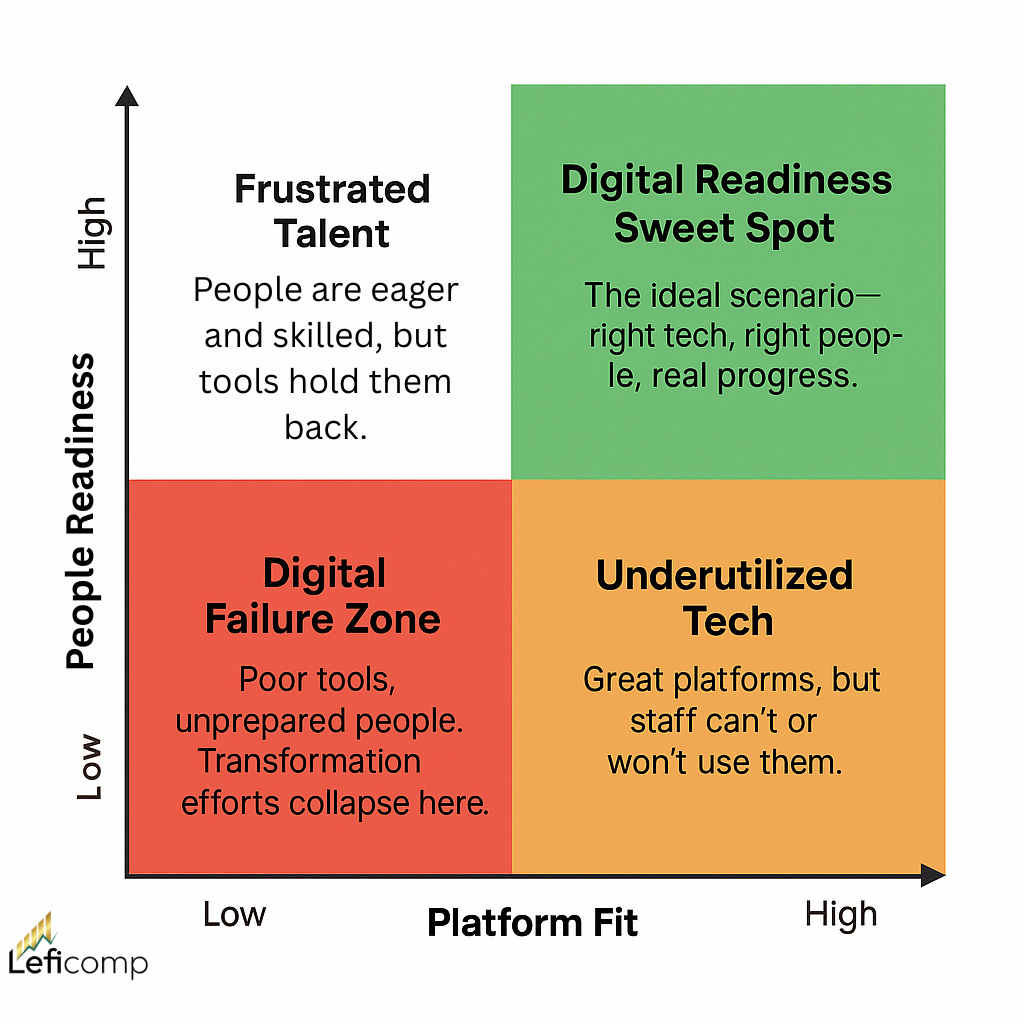In today’s increasingly automated, data-driven landscape, digital transformation is no longer optional. Yet despite the buzz around tools, platforms, and AI, many small and mid-sized businesses find themselves overwhelmed, reactive, and stuck in legacy modes of thinking.
In this article, we explore the real meaning of digital readiness, how to assess it, and why it may be the most critical factor for future-proofing your business.
The question isn’t what tech to adopt. It’s whether your business is digitally ready to adopt, integrate, and sustain the tools that fuel modern growth.

What Is Digital Readiness?
Digital readiness refers to your organization’s ability to successfully adapt to, implement, and extract value from digital tools and technologies. But it goes far beyond software.
At Leficomp, we define digital readiness as:
“A business’s capacity to align people, processes, and technology in service of clear strategic outcomes.”
It means your team has the mindset, the systems, and the operational clarity to:
- Evaluate and choose the right tech for your goals
- Integrate new tools without disrupting performance
- Use data to drive decisions and outcomes
- Innovate rather than just automate
Why Digital Readiness Matters in 2025 and Beyond
Technology has changed our world with unprecedented speed. Innovation cycles are getting shorter and more profound. We are just at the beginning of the sixth wave of innovation powered by AI, and this is your time to ride the wave and set your business up for success in the next decade.
Here are three trends amplifying the urgency:
- The Rise of AI-Enabled Workflows: Integrations between CRMs, email marketing platforms, and AI copilots will be standard by 2026. Only businesses with digital foundations will benefit.
- Remote + Distributed Teams: Tech-enabled collaboration is no longer a perk. It’s a baseline. Without readiness, productivity tanks.
- Customer Expectations Are Changing: Buyers expect faster response times, self-service options, and personalized experiences. Tech supports this, but only if you can implement it well.
The Hidden Cost of Low Digital Readiness
Businesses without digital readiness suffer from:
- Tech stack bloat (tools that overlap or don’t integrate)
- Shadow systems created by overwhelmed teams
- Missed insights due to a lack of usable data
- Lengthy onboarding and training cycles
- Low ROI from digital investments
This shows up as operational drag, poor customer experience, and teams too busy surviving to actually scale.
Quick-Check: Is Your Business Digitally Ready?
Ask yourself:
- Do we have a clear digital strategy, not just a list of tools?
- Are our systems integrated or siloed?
- Does every team member know how digital tools connect to their performance?
- Can we implement new platforms without significant disruption?
- Are we using relevant and timely data to inform decisions?
If you answered “no” or “not sure” to more than two, it’s time for a digital readiness tune-up.
Need help? Our Thrive360 Business Clarity Accelerator is designed to audit and elevate your digital readiness across departments.

Common Mistakes That Undermine Digital Readiness
Most digital transformation initiatives fail not because of poor tech, but because the organization wasn’t ready to implement it.
1. Tool-First Thinking
Buying software because it’s trending, not because it fits your process.
We’ve seen this happen over and over again. In small businesses. In mid-sized organizations. In multi-billion-dollar corporations.
Yes, you are not alone in jumping on a trend and thinking that this tool will somehow transform your business.
2. No Alignment Between Leaders and Operators
Executives choose tools, but the team doesn’t use them or, worse, works around them.
Technology adoption is a vital factor in the success of any digital transformation initiative. Yet, many businesses just pick a tool without getting the buy-in from their teams.
3. Underinvesting in Training and Change Management
Technology alone doesn’t solve problems; people do.
In addition to not getting buy-in, another mistake we see is businesses skipping the training required for users to really adopt the new tool.
No workshops. No discussions or help.
Just jump in the water and learn to swim.
Digital readiness isn’t about how much tech you use. It’s how aligned your business is around using it well.
A Better Way to Build Digital Readiness
At Leficomp, we use a four-part digital readiness framework that maps to the real challenges businesses face:
- Strategic Alignment
Ensure digital initiatives directly support business outcomes, not just “digital transformation” for its own sake. - Operational Clarity
Know what workflows exist, who owns them, and what tools support them. - Platform Fit
Select tools that match the stage, size, and scope of your business. Avoid overbuilding. - People and Culture Readiness
Equip teams with the training, context, and support to adopt tech with confidence.
Implementation Tip: Start With a Single System
Choose one system (CRM, project management, billing, etc.) and ask:
- Is it being used as intended?
- Is data flowing to/from it?
- Are workflows mapped and documented?
Mastering one system creates momentum and builds confidence for broader digital evolution.

Digital Readiness is the New Business Readiness
In 2025, digital readiness isn’t a competitive advantage. It’s a survival requirement.
Your tools, your people, your workflows, and your strategy must be integrated. That’s when digital investments pay off.
Don’t fall for the tech trap. Start with alignment, clarity, and leadership capacity.
Take our free Future Readiness Quiz to find out where you stand, uncover blind spots, and get a personalized action plan to move forward.






